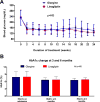A Randomized Controlled Study Comparing a DPP4 Inhibitor (Linagliptin) and Basal Insulin (Glargine) in Patients With Type 2 Diabetes in Long-term Care and Skilled Nursing Facilities: Linagliptin-LTC Trial
- PMID: 29289540
- PMCID: PMC6093296
- DOI: 10.1016/j.jamda.2017.11.002
A Randomized Controlled Study Comparing a DPP4 Inhibitor (Linagliptin) and Basal Insulin (Glargine) in Patients With Type 2 Diabetes in Long-term Care and Skilled Nursing Facilities: Linagliptin-LTC Trial
Erratum in
-
Erratum.J Am Med Dir Assoc. 2019 Jul;20(7):925. doi: 10.1016/j.jamda.2019.04.008. Epub 2019 May 27. J Am Med Dir Assoc. 2019. PMID: 31147287 No abstract available.
Abstract
Objectives: Safe and easily implemented treatment regimens are needed for the management of patients with type 2 diabetes mellitus (T2DM) in long-term care (LTC) and skilled nursing facilities.
Design: This 6-month open-label randomized controlled trial compared the efficacy and safety of a DPP4 inhibitor (linagliptin) and basal insulin (glargine) in LTC residents with T2DM.
Settings: Three LTC institutions affiliated with a community safety-net hospital, US Department of Veterans Affairs and Emory Healthcare System in Atlanta, Georgia.
Participants: A total of 140 residents with T2DM treated with oral antidiabetic agents or low-dose insulin (≤0.1 U/kg/d), with fasting or premeal blood glucose (BG) > 180 mg/dL and/or HbA1c >7.5%.
Intervention: Baseline antidiabetic therapy, except metformin, was discontinued on trial entry. Residents were treated with linagliptin 5 mg/d (n = 67) or glargine at a starting dose of 0.1 U/kg/d (n = 73). Both groups received supplemental rapid-acting insulin before meals for BG > 200 mg/dL.
Measurements: Primary outcome was mean difference in daily BG between groups. Main secondary endpoints included differences in frequency of hypoglycemia, glycosylated hemoglobin (HbA1c), complications, emergency department visits, and hospital transfers.
Results: Treatment with linagliptin resulted in no significant differences in mean daily BG (146 ± 34 mg/dL vs. 157 ± 36 mg/dL, P = .07) compared to glargine. Linagliptin treatment resulted in fewer mild hypoglycemic events <70 mg/dL (3% vs. 37%, P < .001), but there were no differences in BG < 54 mg/dL (P = .06) or <40 mg/dL (P = .05) compared to glargine. There were no significant between-group differences in HbA1c, length of stay, complications, emergency department visits, or hospitalizations.
Conclusion: Treatment with linagliptin resulted in noninferior glycemic control and in significantly lower risk of hypoglycemia compared to insulin glargine in long-term care and skilled nursing facility residents with type 2 diabetes.
Trial registration: ClinicalTrials.gov NCT02061969.
Keywords: DPP4 inhibitors; Incretin; basal insulin; diabetes; glargine; hospital hyperglycemia; linagliptin; long-term care; nursing home; older adults; skilled nursing facilities.
Copyright © 2017 AMDA – The Society for Post-Acute and Long-Term Care Medicine. All rights reserved.
Conflict of interest statement
No other potential conflict of interest relevant to this article was reported.
Figures



References
-
- Centers for Disease Control and Prevention. National diabetes fact sheet: national estimates and general information on diabetes and prediabetes in the United States. Atlanta, GA: U.S. Department of Health and Human Services, Centers for Disease Control and Prevention; 2011. Available at: http://www.cdc.gov/diabetes/pubs/factsheet11.htm.
-
- Mooradian AD, Osterweil D, Petrasek D, Morley JE. Diabetes mellitus in elderly nursing home patients. A survey of clinical characteristics and management. J Am Geriatr Soc. 1988;36:391–396. - PubMed
-
- Funnell MM, Herman WH. Diabetes care policies and practices in Michigan nursing homes, 1991. Diabetes Care. 1995;18:862–866. - PubMed
-
- Hauner H, Kurnaz AA, Haastert B, et al. Undiagnosed diabetes mellitus and metabolic control assessed by HbA(1c) among residents of nursing homes. Exp Clin Endocrinol Diabetes. 2001;109:326–329. - PubMed
Publication types
MeSH terms
Substances
Associated data
Grants and funding
LinkOut - more resources
Full Text Sources
Other Literature Sources
Medical
Miscellaneous

